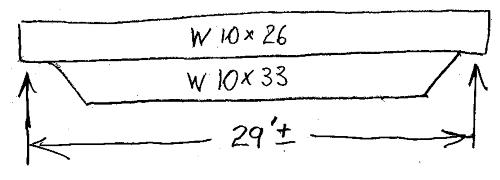I am looking for some input from those with more experience. I seldom do much engineering with steel. I have a client who wants to remove a column in the basement of a single family dwelling. The existing beam is a W10x26. The full span is approximately 29 feet with concrete foundation walls supporting both ends. A steel column is located near the mid-span. So with the column removed the span would be doubled. Obviously the existing beam is very undersized for this condition. I discussed other options such as new columns or walls closer to the ends, but this is not acceptable.
I am looking at typical methods of strengthening the beam. Based upon preliminary engineering I was looking at welding an HSS7x4x1/2 to the bottom flange (7 being the width). I have a bit of headroom to play with, so a deeper option may be used. This gives a deflection at full DL and LL of about 1 inch. I realize that most of the time (if not all of the time) the actual LL will be less. I am a bit nervous about this much deflection because of possible effects at doorways, walls, and tile shower. I have looked at the predicted deflection at the various areas. At some areas is is not bad, but at others I have concerns. My most significant concern is that the wood 4x2 trusses at one side of the beam have two different spans with the change in span occurring near the mid-span of the beam. This will create a significant difference in deflection between two adjacent trusses.
My other concern regards whether there are practical limitations to strengthening a beam (structural or serviceability). Any input on where to terminate the new member would also be helpful (other than where is is not needed from a moment or shear? standpoint). I assume spaced and staggered welding is advisable, but should there be continuous welding at some length at each end? Also, welding across the end? Any other special considerations for HSS?
Is this something that should work or or am I asking the reinforcing to do too much? New beam may be an option, but may not be practical or cost effective.
Sorry for the long post.
I am looking at typical methods of strengthening the beam. Based upon preliminary engineering I was looking at welding an HSS7x4x1/2 to the bottom flange (7 being the width). I have a bit of headroom to play with, so a deeper option may be used. This gives a deflection at full DL and LL of about 1 inch. I realize that most of the time (if not all of the time) the actual LL will be less. I am a bit nervous about this much deflection because of possible effects at doorways, walls, and tile shower. I have looked at the predicted deflection at the various areas. At some areas is is not bad, but at others I have concerns. My most significant concern is that the wood 4x2 trusses at one side of the beam have two different spans with the change in span occurring near the mid-span of the beam. This will create a significant difference in deflection between two adjacent trusses.
My other concern regards whether there are practical limitations to strengthening a beam (structural or serviceability). Any input on where to terminate the new member would also be helpful (other than where is is not needed from a moment or shear? standpoint). I assume spaced and staggered welding is advisable, but should there be continuous welding at some length at each end? Also, welding across the end? Any other special considerations for HSS?
Is this something that should work or or am I asking the reinforcing to do too much? New beam may be an option, but may not be practical or cost effective.
Sorry for the long post.


![[idea] [idea] [idea]](/data/assets/smilies/idea.gif)
![[r2d2] [r2d2] [r2d2]](/data/assets/smilies/r2d2.gif)